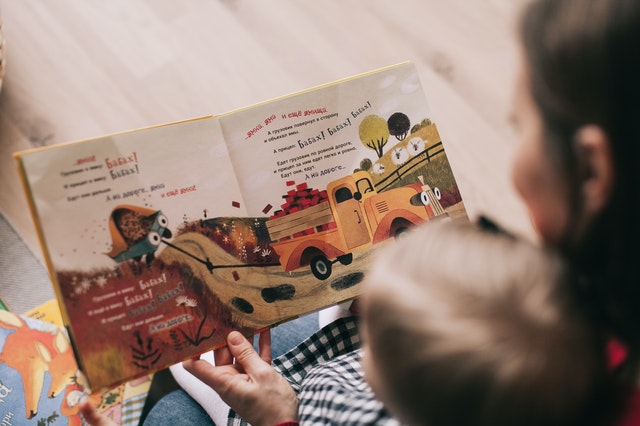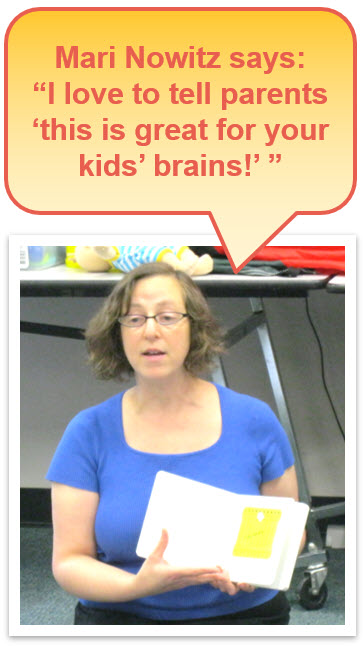Library Storytimes during COVID-19 – Connecting with Families
In part two of a two-part series, Saroj Ghoting, early childhood literacy consultant, looks at ways to connect with families during virtual storytimes, to share tips and support with parents and caregivers. See also Part One.

Now that you've engaged with children in your virtual storytime, another goal might be to connect with families in your community who are seeking activities to do with their children. You can offer many tips sprinkled throughout your storytime or you may decide the information warrants its own presentation, just for families.
What is it like sharing books at home?
Think about how families are experiencing this separation from the reading resources of the library. It’s likely they have the same stack of books they’ve had since their library closed. Some will not be able to buy books to add to their collection. Parents may also be trying to stretch the books they have; books they got for their two-year-old they may now need to be shared with the four-year-old and the eight-year-old, and the ones for the eight-year-old with the younger children.
Your suggestions can help them make the most out of the books that they have.
- Assure them that children learn through repetition and it’s okay to read the same book over and over; they can read it in different ways, at different sittings. The child can do some of the storytelling, retelling the story in the book or using their imagination to make up their own story. Families can focus on small details in the illustrations that add meaning or stop at a key plot point in the book and imagine a different ending.
- Offer ideas for ways to share one book with different age levels. For example, a toddler can label pictures and say or repeat the sounds of animals or vehicles in a book, a preschooler can say a repeated phrase and respond to questions related to their own experiences, while the eight-year-old may be able to expand the story and talk about choices a character made.
Literacy enhancement without books
In addition to stretching their supply of books, it’s wonderful to offer non-book ways to enhance literacy. Sharing stories orally is a wonderful (and often lost) tradition. Children love to hear stories about when their parents were kids. Sherry Norfolk, a practitioner who took WebJunction’s Supercharged Storytimes Train the Trainer course, notes that some classic stories like the Three Little Pigs, Three Bears, or Three Billy Goats Gruff lend themselves to dramatization. Kids can play the different pigs and someone gets to be the wolf. Many children will relish the line, “I’ll huff, and I’ll puff, and I’ll blow your house down.” You can extend the story by building houses with blocks and cushions and knocking them down. It’s also fun to make up stories, or dream up the next adventure for Winnie the Pooh.
Caregivers can supercharge early literacy too
With children not going to Pre-K or other early learning environments, parents may be especially open to learning about the ways they are supporting their children’s learning.
- This is a great opportunity to emphasize print motivation–the enjoyment around books and reading. Researchers have found that children who have had positive experiences around books and reading are more likely to stay engaged when they are formally being taught to read, even if it is difficult.
- Parents might welcome the tip that they don’t need to worry if they don’t get through the whole book. It’s important that the interaction between the parent, the child and the book remain positive.
- Families will appreciate learning some of the reasons for what you do during storytime, and they can use those tips at home.
- For example, “I am talking about the shapes in the pictures because children recognize letters by their shapes. Recognizing shapes helps them later identify letters. Talking with your child about shapes in the world around us will help your child build literacy skills.”
- “When you add information or new words to pictures or stories in books, you help them learn about the world around them. This builds their background knowledge which will later help them understand what they will read.”
- “When we sing with children, there is a distinct note for each syllable, so they are hearing the smaller sounds in words which will later help them sound out words when they learn to read.” Your tip can come before or after you share a book or song.
- To further explore parent and caregiver tips, please visit this article, a WebJunction YouTube playlist, featuring librarian Mari Nowitz, demonstrating several tips, and Saroj’s video playlist at earlylit.net/videos.
It may make more sense to compile these messages for parents and caregivers into a short video addressed directly to the parent or caregiver instead of trying to insert them in a virtual storytime. Families appreciate all the support they are getting in these uncertain times, and these tips framed in an encouraging and empowering way can be so helpful.
Exploring different ways to support families in our current predicament helps solidify the partnership between families and libraries and helps us think about how we might enhance library services after the pandemic is over—a silver lining!

